Copyright Bernard Welchman 2021

About the Timber
A brief description of the timbers used
Click on an image to enlarge
Mediterranean Olivewood
Olive
wood
is
a
beautiful
type
of
wood
and
is
used
in
many
luxury
goods.
Olives
are
a
huge
economic
importance
in
the
Mediterranean
and
the
trees
are
never
harvested
for
their
wood.
So,
all
olive
wood
is
limited
to
tree
clippings,
branches,
and
trees
destroyed
by
storms
or
disease.
The
wood
itself
is
fairly
easy
to
work
with,
the
only
problems
that
may
occur
is
that
the
wood
is
subject to cracking when working with a lot of grain
The
trees
themselves
grow
from
25
to
50
feet
tall.
The
diameter
of
these
trees
can
reach
anywhere
from
3-5
feet
and
the
colour
is
a
creamy
yellow/brown
with
dark
brown
or
black
contrasting
grain.
It
is
this
that
really
makes
olive
wood
stand
out
so
much
as
the
grain can be curly or wavy in shape and also may be straight, interlocked, or wild.
Olive
trees
have
been
around
for
a
very
long
time.
The
earliest
record
of
olive
tree
groves
were
recorded
to
be
around
4000
B.C.
Many
people
draw
olive
trees
in
backgrounds
of
religious
paintings
because
they
are
prevalent
in
the
holy
land
of
Jerusalem.
Olive
trees are actually quite significant in most religions, however for everybody olive trees are a symbol of peace and beauty.
Oak
Oak
is
probably
one
of
the
most
well
known
deciduous
timbers.
There
are
said
to
be
over
500
different
knowns
varieties
of
this
tree
and
is
known
for
its
strength
and
was
extensively
used
in
ship
building
from
at
least
the
Viking
era.
It
was
also
used
in
the
making
of
good quality furniture, barrels and numerous other items.
A
lot
of
people
do
not
like
using
oak
as
the
grain
can
be
very
course,
difficult
to
work
and
get
a
glass
like
finish.
However,
I
feel
that
most
people
buy
a
wooden
pen
for
it
to
feel
like
a
wooden
pen
and
not
a
piece
of
plastic.
Most
of
the
oak
that
I
use
is
English,
but
it
is
not always easy to tell particularly that sourced from old furniture.
Red Oak
Widespread
throughout
Eastern
United
States
Oaks
they
are
the
most
abundant
species
group
growing
in
the
Eastern
hardwood
forests.
Red
oaks
grow
more
abundantly
than
white
oaks.
The
red
oak
group
comprises
many
species,
of
which
about
eight
are
commercial.
The
colour
of
Red
Oak
varies
from
white
to
a
slight
pinkish/brown.
The
wood
is
similar
in
general
appearance
to
white
oak,
but
with
a
slightly less-pronounced figure due to the smaller rays. The wood is mostly straight-grained, with a coarse texture.
Red
oak
is
hard
and
heavy
and
can
be
stained
to
a
golden
finish,
with
a
wide
range
of
finish
tones.
And
it
is
used
for
furniture,
flooring,
architectural millwork, doors, kitchen cabinets and has many more uses
Sycamore
Sycamore
trees
are
native
to
the
UK,
deciduous
and
fairly
commonly
found
from
well
managed,
sustainable
woodland
sources.
The
trees
can
grow
to
enormous
dimensions
of
50m
height
and
1.5m
diameter
or
more
and
so
it
follows
that
Sycamore
logs
are
substantial
in
size
too.
As
a
timber
its
hardwood,
pale
white
wood.
The
sap
and
heartwood
are
the
same
colour
size
and
visual
qualities.
Its
grain
is
broad,
strong
and
vibrant
because
the
annual
growth
rings
of
the
tree
are
very
marked.
The
overall
colouring
is
creamy
yellow
with
the
marked
growth
rings
a
rich
reddy-brown.
The
European
Sycamore
is
known
to
be
the
hard
and
strong
but
it’s
not
durable
so
must
not be used for external doors, windows, exterior cladding or garden furniture.
Yew
Yew
is
one
of
the
hardest
softwoods
and
has
a
good
straight
grain
and
a
yellowish
colour.
It
is
one
of
the
oldest
living
trees
and
are
often
found
in
Churchyards,
where
is
a
number
of
cases
are
older
than
the
actual
church
itself.
It
is
thought
that
they
can
live
to
3000
years
old
although
those
over
1500
years
are
more
common.
It
was
the
main
timber
used
for
Longbows
during
the
Middle
Ages.
It
has
also been used for fine furniture and cabinet making, particularly as a veneer.
Zebrano
This
wood
is
also
known
as
Zebrawood
due
to
the
colouration
of
brown
or
cream
with
dark
blackish
brown
streaks
vaguely
resembling
a
zebra’s
stripes.
Depending
on
whether
the
wood
is
flatsawn
or
quartersawn,
the
stripes
can
be
either
chaotic
and
wavy
(flatsawn), or somewhat uniform (quartersawn).
The
wood
has
a
fairly
coarse
texture
and
open
pores
with
the
Grain
usually
wavy
or
interlocked.
The
wood
saws
well
but
can
be
very
difficult
to
plane
or
surface
due
to
the
prevalence
of
interlocking
grain.
Tearout
is
common.
Zebrawood
glues
and
finishes
well,
though
a
transparent
pore
filler
may
be
necessary
for
the
large
open
pores
which
occur
on
both
dark
and
light
surfaces.
It
is
becoming
a rare timber due to the decline in its natural range.

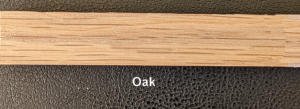
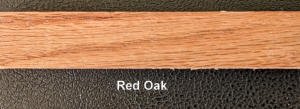
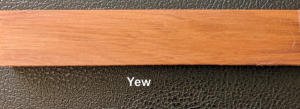
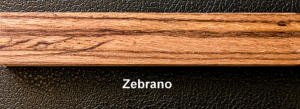
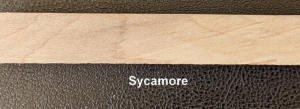
Panga Panga
Panga
Panga
is
from
East
and
South-East
Africa
(Congo,
Kenya,
Mozambique,
Tanzania,
Zimbabwe).
This
species
is
sometimes
confused with its cousin Wenge which is very similar in appearance but grows in West and Central Africa.
This
species
is
a
deep,
dark
chocolate
brown
with
alternating
depths
of
colour
and
whitish/yellowish
tissue
which
has
the
effect
of
stripes
and
swirls.
This
tissue
sometimes
appears
light
spots
on
the
timber
This
species
looks
superb
when
laid
as
a
parquet
wood
block
floor,
with
the
bold
wavy-stripe
appearance
giving
an
added
dimension
and
interest.
It
also
works
well
as
a
striking
border
to
a paler colour parquet block, such as sycamore or maple.
A
hard
wood,
stable
and
heavy,
so
as
a
consequence
it
has
exceptionally
good
‘resistance
to
wear’
properties.
It
glues
satisfactorily
and
will
take
a
polish
well,
with
a
very
faint
scent
when
sanded.
A
dense
timber,
which
feels
cool
and
hard
to
the
touch
with
a
smooth feel to it. This is an unusual species of great interest and quality.
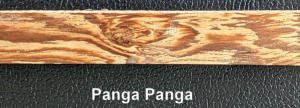
Black Cherry
Black
Cherry
(Also
Known
as
American
Cherry,
Cabinet
Cherry
and
Rum
Cherry)
has
a
heartwood
that
is
a
light
pinkish
brown
when
freshly
cut,
darkening
to
a
medium
reddish
brown
with
time
and
upon
exposure
to
light.
The
grain
is
usually
straight
and
easy
to work—with the exception of figured pieces with curly grain patterns.
Cherry
is
known
as
being
one
of
the
best
all-around
woods
for
workability.
It
is
stable,
straight-grained,
and
machines
well.
It
is
mostly used for cabinet making, fine furniture, flooring, interior millwork, veneer, turned objects, and small specialty wood items.

Copyright Bernard Welchman 2021
About the Timber
A brief description of the timbers used
Click on an image to enlarge
Mediterranean Olivewood
Olive
wood
is
a
beautiful
type
of
wood
and
is
used
in
many
luxury
goods.
Olives
are
a
huge
economic
importance
in
the
Mediterranean
and
the
trees
are
never
harvested
for
their
wood.
So,
all
olive
wood
is
limited
to
tree
clippings,
branches,
and
trees
destroyed
by
storms
or
disease.
The
wood
itself
is
fairly
easy
to
work
with,
the
only
problems
that
may
occur
is
that
the
wood
is
subject
to
cracking
when
working
with a lot of grain
The
trees
themselves
grow
from
25
to
50
feet
tall.
The
diameter
of
these
trees
can
reach
anywhere
from
3-5
feet
and
the
colour
is
a
creamy
yellow/brown
with
dark
brown
or
black
contrasting
grain.
It
is
this
that
really
makes
olive
wood
stand
out
so
much
as
the
grain
can
be
curly
or
wavy
in
shape
and also may be straight, interlocked, or wild.
Olive
trees
have
been
around
for
a
very
long
time.
The
earliest
record
of
olive
tree
groves
were
recorded
to
be
around
4000
B.C.
Many
people
draw
olive
trees
in
backgrounds
of
religious
paintings
because
they
are
prevalent
in
the
holy
land
of
Jerusalem.
Olive
trees
are
actually
quite
significant
in
most
religions,
however
for
everybody
olive
trees are a symbol of peace and beauty.
Oak
Oak
is
probably
one
of
the
most
well
known
deciduous
timbers.
There
are
said
to
be
over
500
different
knowns
varieties
of
this
tree
and
is
known
for
its
strength
and
was
extensively
used
in
ship
building
from
at
least
the
Viking
era.
It
was
also
used
in
the
making
of
good
quality
furniture,
barrels and numerous other items.
A
lot
of
people
do
not
like
using
oak
as
the
grain
can
be
very
course,
difficult
to
work
and
get
a
glass
like
finish.
However,
I
feel
that
most
people
buy
a
wooden
pen
for
it
to
feel
like
a
wooden
pen
and
not
a
piece
of
plastic.
Most
of
the
oak
that
I
use
is
English,
but
it
is
not
always
easy
to
tell
particularly
that sourced from old furniture.
Red Oak
Widespread
throughout
Eastern
United
States
Oaks
they
are
the
most
abundant
species
group
growing
in
the
Eastern
hardwood
forests.
Red
oaks
grow
more
abundantly
than
white
oaks.
The
red
oak
group
comprises
many
species,
of
which
about
eight
are
commercial.
The
colour
of
Red
Oak
varies
from
white
to
a
slight
pinkish/brown.
The
wood
is
similar
in
general
appearance
to
white
oak,
but
with
a
slightly
less-pronounced
figure
due
to
the
smaller
rays.
The
wood
is
mostly straight-grained, with a coarse texture.
Red
oak
is
hard
and
heavy
and
can
be
stained
to
a
golden
finish,
with
a
wide
range
of
finish
tones.
And
it
is
used
for
furniture,
flooring,
architectural
millwork,
doors,
kitchen
cabinets and has many more uses
Sycamore
Sycamore
trees
are
native
to
the
UK,
deciduous
and
fairly
commonly
found
from
well
managed,
sustainable
woodland
sources.
The
trees
can
grow
to
enormous
dimensions
of
50m
height
and
1.5m
diameter
or
more
and
so
it
follows
that
Sycamore
logs
are
substantial
in
size
too.
As
a
timber
its
hardwood,
pale
white
wood.
The
sap
and
heartwood
are
the
same
colour
size
and
visual
qualities.
Its
grain
is
broad,
strong
and
vibrant
because
the
annual
growth
rings
of
the
tree
are
very
marked.
The
overall
colouring
is
creamy
yellow
with
the
marked
growth
rings
a
rich
reddy-brown.
The
European
Sycamore
is
known
to
be
the
hard
and
strong
but
it’s
not
durable
so
must
not
be
used
for
external
doors,
windows,
exterior cladding or garden furniture.
Yew
Yew
is
one
of
the
hardest
softwoods
and
has
a
good
straight
grain
and
a
yellowish
colour.
It
is
one
of
the
oldest
living
trees
and
are
often
found
in
Churchyards,
where
is
a
number
of
cases
are
older
than
the
actual
church
itself.
It
is
thought
that
they
can
live
to
3000
years
old
although
those
over
1500
years
are
more
common.
It
was
the
main
timber
used
for
Longbows
during
the
Middle
Ages.
It
has
also
been
used
for
fine furniture and cabinet making, particularly as a veneer.
Zebrano
This
wood
is
also
known
as
Zebrawood
due
to
the
colouration
of
brown
or
cream
with
dark
blackish
brown
streaks
vaguely
resembling
a
zebra’s
stripes.
Depending
on
whether
the
wood
is
flatsawn
or
quartersawn,
the
stripes
can
be
either
chaotic
and
wavy
(flatsawn),
or
somewhat
uniform
(quartersawn).
The
wood
has
a
fairly
coarse
texture
and
open
pores
with
the
Grain
usually
wavy
or
interlocked.
The
wood
saws
well
but
can
be
very
difficult
to
plane
or
surface
due
to
the
prevalence
of
interlocking
grain.
Tearout
is
common.
Zebrawood
glues
and
finishes
well,
though
a
transparent
pore
filler
may
be
necessary
for
the
large
open
pores
which
occur
on
both
dark
and
light
surfaces.
It
is
becoming
a
rare
timber
due
to
the
decline in its natural range.






Panga Panga
Panga
Panga
is
from
East
and
South-East
Africa
(Congo,
Kenya,
Mozambique,
Tanzania,
Zimbabwe).
This
species
is
sometimes
confused
with
its
cousin
Wenge
which
is
very
similar in appearance but grows in West and Central Africa.
This
species
is
a
deep,
dark
chocolate
brown
with
alternating
depths
of
colour
and
whitish/yellowish
tissue
which
has
the
effect
of
stripes
and
swirls.
This
tissue
sometimes
appears
light
spots
on
the
timber
This
species
looks
superb
when
laid
as
a
parquet
wood
block
floor,
with
the
bold
wavy-stripe
appearance
giving
an
added
dimension
and
interest.
It
also
works
well
as
a
striking
border
to
a
paler
colour
parquet
block, such as sycamore or maple.
A
hard
wood,
stable
and
heavy,
so
as
a
consequence
it
has
exceptionally
good
‘resistance
to
wear’
properties.
It
glues
satisfactorily
and
will
take
a
polish
well,
with
a
very
faint
scent
when
sanded.
A
dense
timber,
which
feels
cool
and
hard
to
the
touch
with
a
smooth
feel
to
it.
This
is
an
unusual
species of great interest and quality.
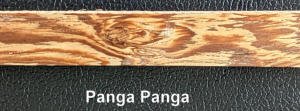
Black Cherry
Black
Cherry
(Also
Known
as
American
Cherry,
Cabinet
Cherry
and
Rum
Cherry)
has
a
heartwood
that
is
a
light
pinkish
brown
when
freshly
cut,
darkening
to
a
medium
reddish
brown
with
time
and
upon
exposure
to
light.
The
grain
is
usually
straight
and
easy
to
work—with
the
exception of figured pieces with curly grain patterns.
Cherry
is
known
as
being
one
of
the
best
all-around
woods
for
workability.
It
is
stable,
straight-grained,
and
machines
well.
It
is
mostly
used
for
cabinet
making,
fine
furniture,
flooring,
interior
millwork,
veneer,
turned
objects,
and
small
specialty wood items.






































